Risk Assessment of Coal Mine Gas Explosion Based on Fault Tree Analysis and Fuzzy Polymorphic Bayesian Network: A Case Study of Wangzhuang Coal Mine
(This article belongs to the Section Energy Systems)
Abstract
:1. Introduction
2. Materials and Methods
2.1. Bayesian Network Structure Learning
2.1.1. Establishment of Fault Tree of Coal Mine Gas Explosion
2.1.2. Polymorphism Classification of Risk Factors Based on ALARP
2.1.3. Determination of Bayesian Network Structure
2.2. Bayesian Network Parameter Learning
2.2.1. The Prior Probability Determination of Root Nodes Based on Fuzzy Theory
2.2.2. Determination of Intermediate Node Conditional Probability
- (1)
- Objective assignment
- (2)
- Combination of subjective and objective assignment
2.3. Construction and Analysis of Polymorphic Bayesian Networks
- (1)
- Causal reasoning
- (2)
- Diagnostic reasoning
- (3)
- Sensitivity analysis
3. Results
3.1. Bayesian Network Parameters
- (1)
- Prior probability of root node
- (2)
- Conditional probability of intermediate nodes
3.2. Causal Reasoning
3.3. Diagnostic Reasoning
3.4. Sensitivity Analysis
3.5. Risk Prevention and Control
4. Discussion
5. Conclusions
Author Contributions
Funding
Institutional Review Board Statement
Informed Consent Statement
Data Availability Statement
Acknowledgments
Conflicts of Interest
References
- Xue, D.; Hu, X.; Cheng, W.; Yu, X.; Wu, M.; Zhao, Y.; Lu, Y.; Pan, R.; Niu, H.; Hu, S. Development of a novel composite inhibitor modified with proanthocyanidins and mixed with ammonium polyphosphate. Energy 2020, 213, 118901. [Google Scholar]
- Li, M.; Wang, D.; He, S.; Shao, Z.; Shen, Y. Experimental study on foaming properties of anion-cation compound foaming agent to prevent coal spontaneous combustion. Colloids Surf. A Physicochem. Eng. Asp. 2019, 581, 123847. [Google Scholar]
- Wang, Y.; Fu, G.; Lyu, Q.; Wu, Y.; Jia, Q.; Yang, X.; Li, X. Reform and development of coal mine safety in China: An analysis from government supervision, technical equipment, and miner education. Resour. Policy 2022, 77, 102777. [Google Scholar]
- Xie, X.; Shen, S.; Fu, G.; Shu, X.; Hu, J.; Jia, Q.; Shi, Z. Accident case data–accident cause model hybrid-driven coal and gas outburst accident analysis: Evidence from 84 accidents in China during 2008–2018. Process Saf. Environ. Prot. 2022, 164, 67–90. [Google Scholar]
- Niu, L.; Zhao, J.; Yang, J. Risk Assessment of Unsafe Acts in Coal Mine Gas Explosion Accidents Based on HFACS-GE and Bayesian Networks. Processes 2023, 11, 554. [Google Scholar]
- Tong, R.; Yang, Y.; Ma, X.; Zhang, Y.; Li, S.; Yang, H. Risk assessment of Miners’ unsafe behaviors: A case study of gas explosion accidents in coal mine, china. Int. J. Environ. Res. Public Health 2019, 16, 1765. [Google Scholar]
- Li, M.; Wang, H.; Wang, D.; Shao, Z.; He, S. Risk assessment of gas explosion in coal mines based on fuzzy AHP and bayesian network. Process Saf. Environ. Prot. 2020, 135, 207–218. [Google Scholar]
- Bagherpour, R.; Yarahmadi, R.; Khademian, A. Safety risk assessment of Iran’s underground coal mines based on preventive and preparative measures. Hum. Ecol. Risk Assess. 2015, 21, 2223–2238. [Google Scholar]
- Kasap, Y.; Subaşı, E. Risk assessment of occupational groups working in open pit mining: Analytic Hierarchy Process. J. Sust. Min. 2017, 16, 38–46. [Google Scholar]
- Domínguez, C.R.; Martínez, I.V.; Peña, P.M.P.; Ochoa, A.R. Analysis and evaluation of risks in underground mining using the decision matrix risk-assessment (DMRA) technique, in Guanajuato, Mexico. J. Sust. Min. 2019, 18, 52–59. [Google Scholar]
- Mottahedi, A.; Ataei, M. Fuzzy fault tree analysis for coal burst occurrence probability in underground coal mining. Tunn. Undergr. Space Technol. 2019, 83, 165–174. [Google Scholar]
- Pejic, L.M.; Torrent, J.G.; Querol, E.; Lebecki, K. A new simple methodology for evaluation of explosion risk in underground coal mines. J. Loss Prev. Process Ind. 2013, 26, 1524–1529. [Google Scholar]
- Osarogiagbon, A.U.; Khan, F.; Venkatesan, R.; Gillard, P. Review and analysis of supervised machine learning algorithms for hazardous events in drilling operations. Process Saf. Environ. Prot. 2021, 147, 367–384. [Google Scholar]
- Khakzad, N.; Khan, F.; Amyotte, P. Safety analysis in process facilities: Comparison of fault tree and Bayesian network approaches. Reliab. Eng. Syst. Saf. 2011, 96, 925–932. [Google Scholar]
- Zhang, L.; Wu, X.; Qin, Y.; Skibniewski, M.J.; Liu, W. Towards a fuzzy Bayesian network based approach for safety risk analysis of tunnel-induced pipeline damage. Risk Anal. 2016, 36, 278–301. [Google Scholar]
- Tong, X.; Fang, W.; Yuan, S.; Ma, J.; Bai, Y. Application of Bayesian approach to the assessment of mine gas explosion. J. Loss Prev. Process Ind. 2018, 54, 238–245. [Google Scholar]
- Zarei, E.; Khakzad, N.; Cozzani, V.; Reniers, G. Safety analysis of process systems using Fuzzy Bayesian Network (FBN). J. Loss Prev. Process Ind. 2019, 57, 7–16. [Google Scholar]
- Li, Z.; Wang, X.; Gong, S.; Sun, N.; Tong, R. Risk assessment of unsafe behavior in university laboratories using the HFACS-UL and a fuzzy Bayesian network. J. Saf. Res. 2022, 82, 13–27. [Google Scholar]
- Shi, L.; Wang, J.; Zhang, G.; Cheng, X.; Zhao, X. A risk assessment method to quantitatively investigate the methane explosion in underground coal mine. Process Saf. Environ. Prot. 2017, 107, 317–333. [Google Scholar]
- Khan, F.; Rathnayaka, S.; Ahmed, S. Methods and models in process safety and risk management: Past, present and future. Process Saf. Environ. Prot. 2015, 98, 116–147. [Google Scholar]
- Qiao, W. Analysis and measurement of multifactor risk in underground coal mine accidents based on coupling theory. Reliab. Eng. Syst. Saf. 2021, 208, 107433. [Google Scholar] [CrossRef]
- Li, F.; He, X.; Zhang, Y.; Wang, C.; Tang, J.; Sun, R. Superposition risk assessment of the working position of gas explosions in chinese coal mines. Process Saf. Environ. Prot. 2022, 167, 274–283. [Google Scholar] [CrossRef]
- Ruijters, E.; Stoelinga, M. Fault tree analysis: A survey of the state-of-the-art in modeling, analysis and tools. Comput. Sci. Rev. 2015, 15, 29–62. [Google Scholar]
- Wang, Y.; Fu, G.; Lyu, Q.; Li, X.; Chen, Y.; Wu, Y.; Xie, X. Modelling and analysis of unsafe acts in coal mine gas explosion accidents based on network theory. Process Saf. Environ. Prot. 2023, 170, 28–44. [Google Scholar]
- Maselli, G.; Macchiaroli, M.; Nesticò, A. ALARP criteria to estimate acceptability and tolerability thresholds of the investment risk. Appl. Sci. 2021, 11, 9086. [Google Scholar] [CrossRef]
- Kotre, C.J. Application of ALARP cost-benefit analysis to hospital-based radiation protection. J. Radiol. Prot. 2022, 42, 041509. [Google Scholar] [CrossRef]
- Zadeh, L. Fuzzy sets. Inf. Control 1965, 8, 338–353. [Google Scholar] [CrossRef]
- Guo, X.; Ji, J.; Khan, F.; Ding, L.; Yang, Y. Fuzzy Bayesian network based on an improved similarity aggregation method for risk assessment of storage tank accident. Process Saf. Environ. Prot. 2021, 149, 817–830. [Google Scholar] [CrossRef]
- Oniśko, A.; Druzdzel, M.J.; Wasyluk, H. Learning Bayesian network parameters from small data sets: Application of Noisy-OR gates. Int. J. Approx. Reason. 2001, 27, 165–182. [Google Scholar] [CrossRef]
- Wang, W.C.; Li, Y.C.; He, C.P.; Zhang, B.; Zhao, H. Balanced Ventilation Principle in the Application of Shigetai Coal Mine Ventilation System Optimization. AMM 2013, 392, 95–99. [Google Scholar] [CrossRef]
- Chen, J.; Lu, Y.; Tang, G.; Yang, Y.; Shao, S.; Ding, Y. Research and prevention of upper remaining coal spontaneous combustion induced by air leakage in multi-inclination regenerated roof: A case study in the Luwa coal mine, China. Energy 2023, 275, 127484. [Google Scholar] [CrossRef]

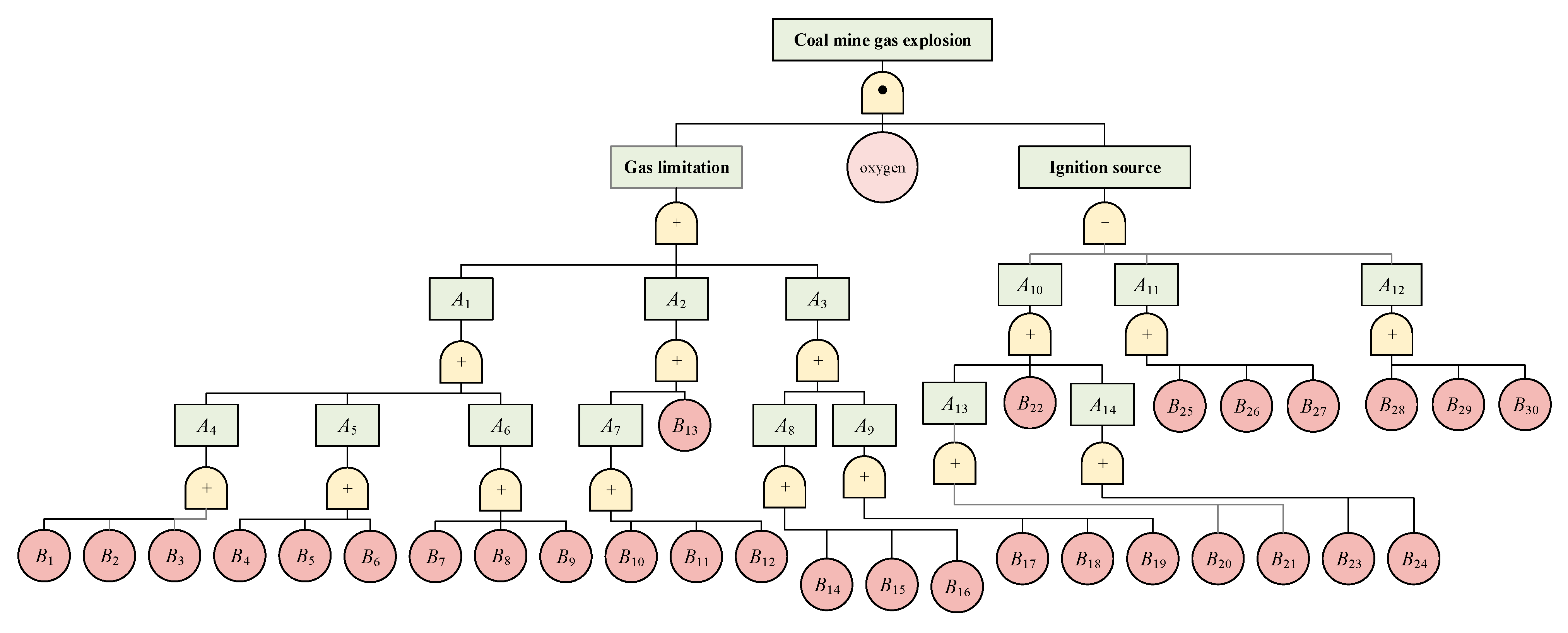
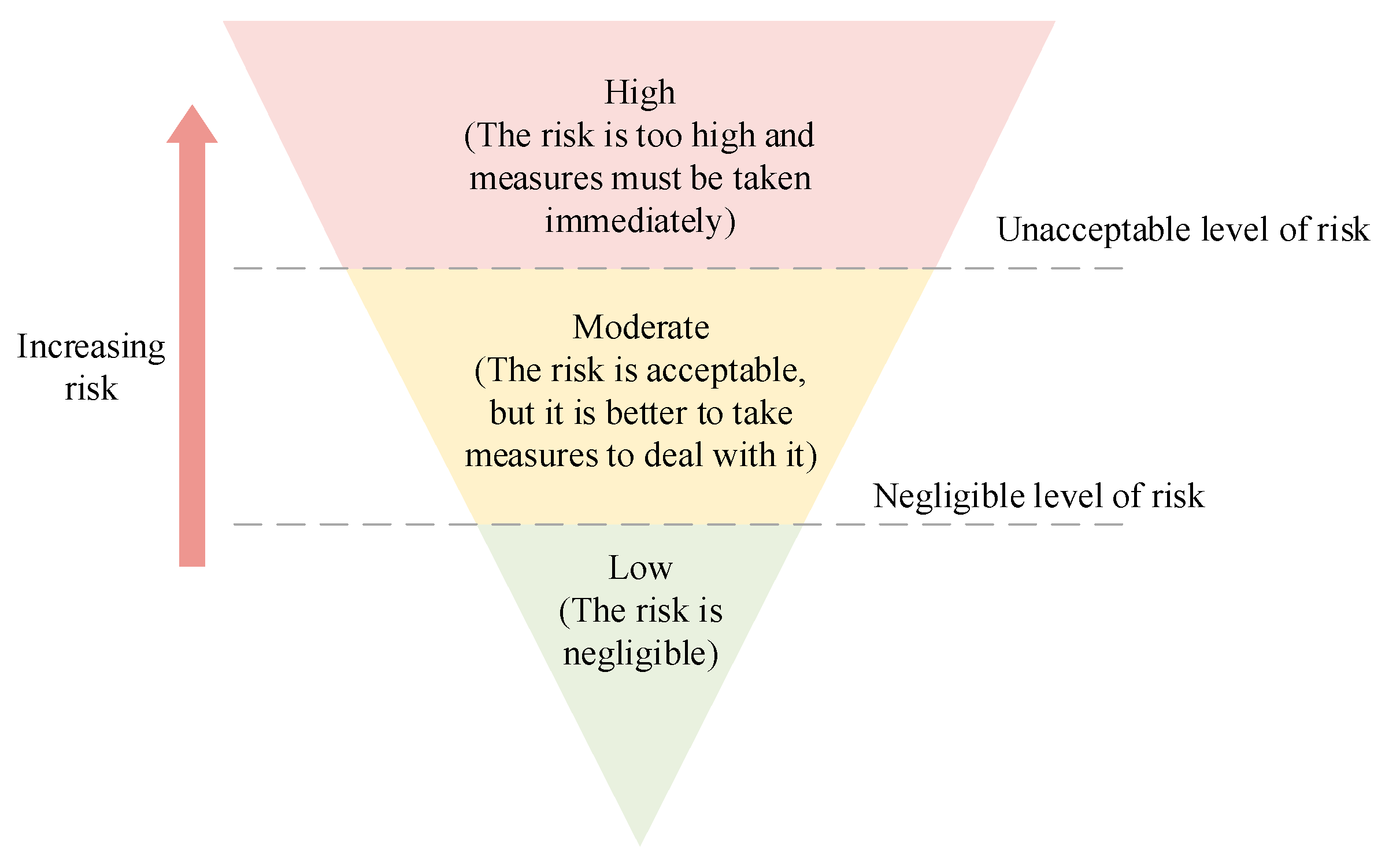
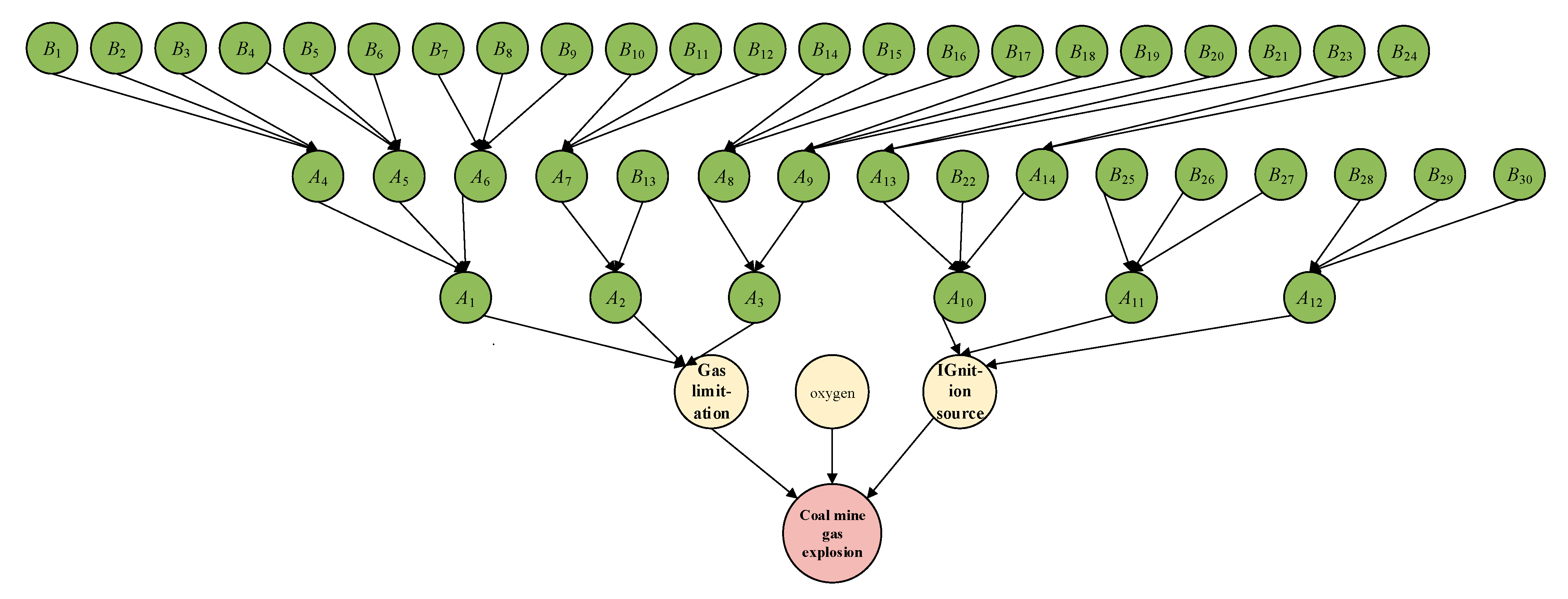
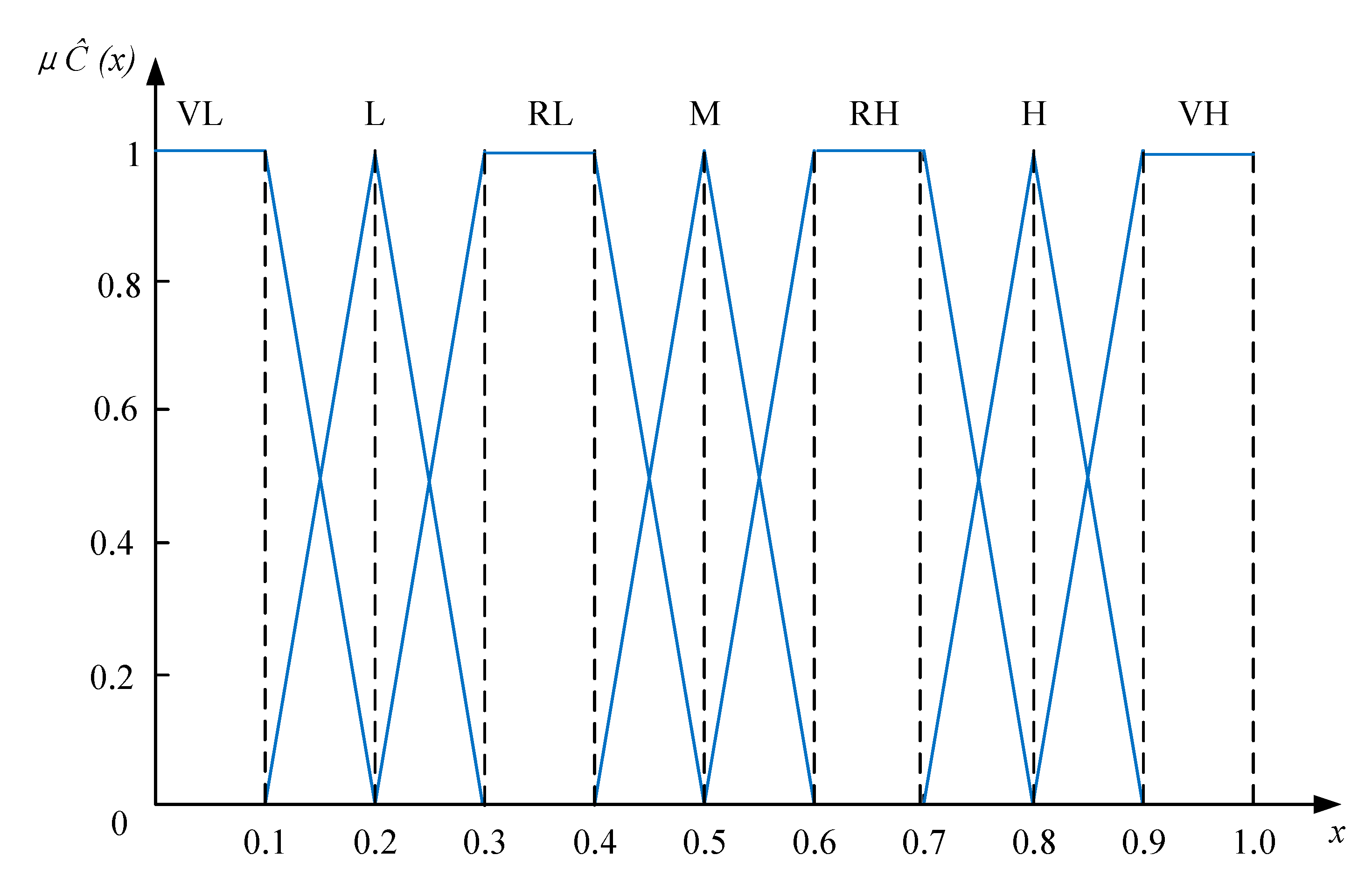

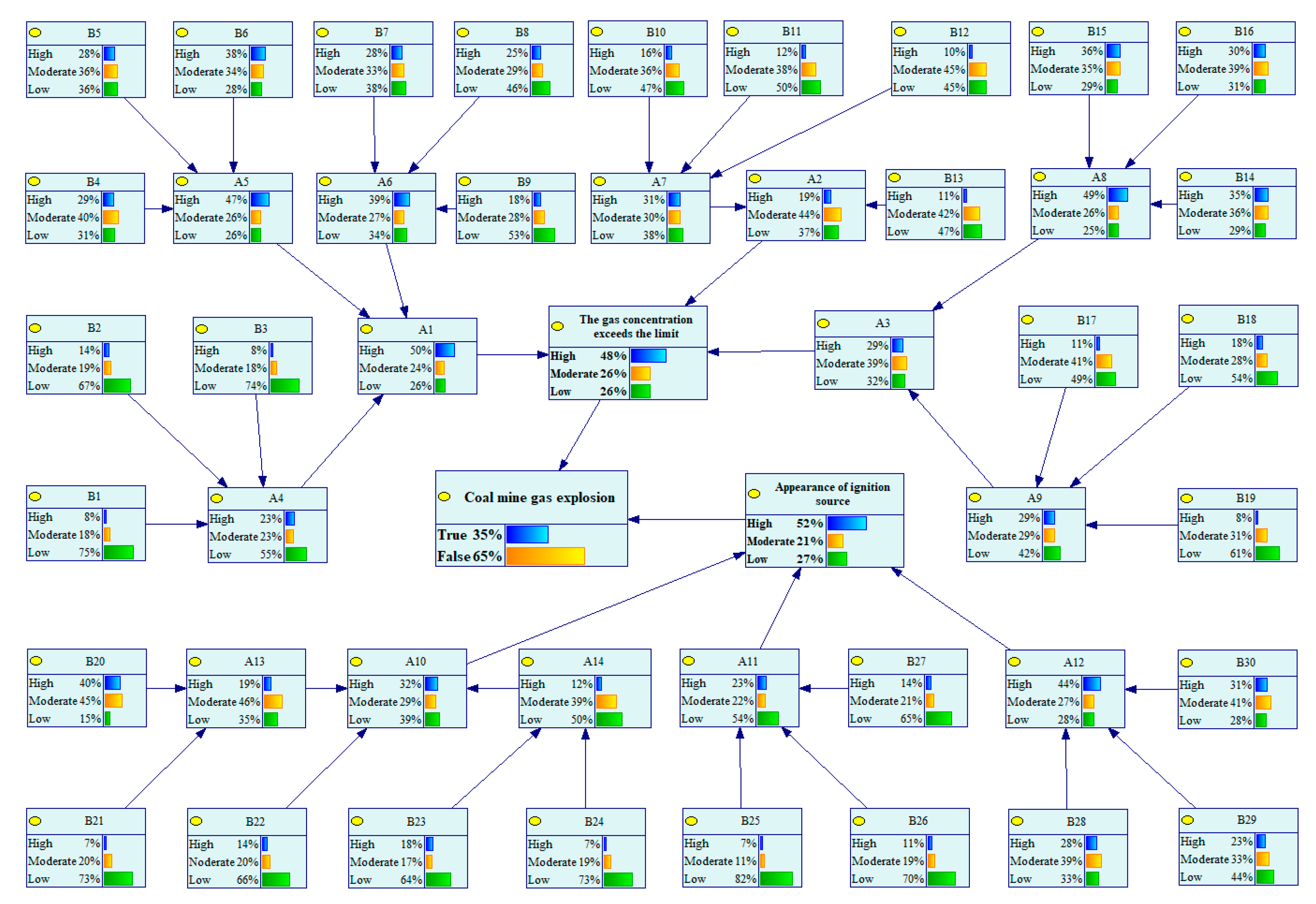
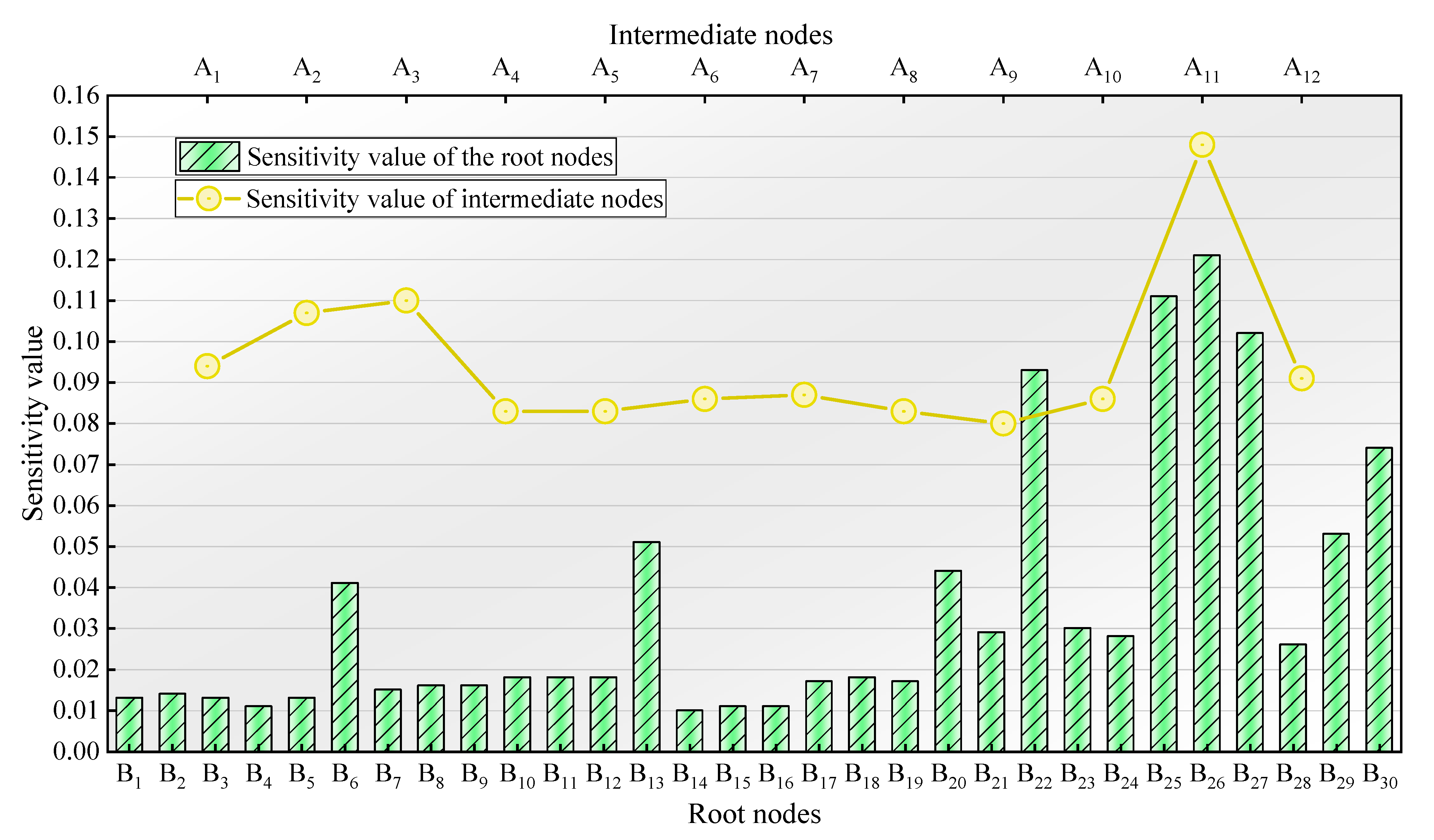
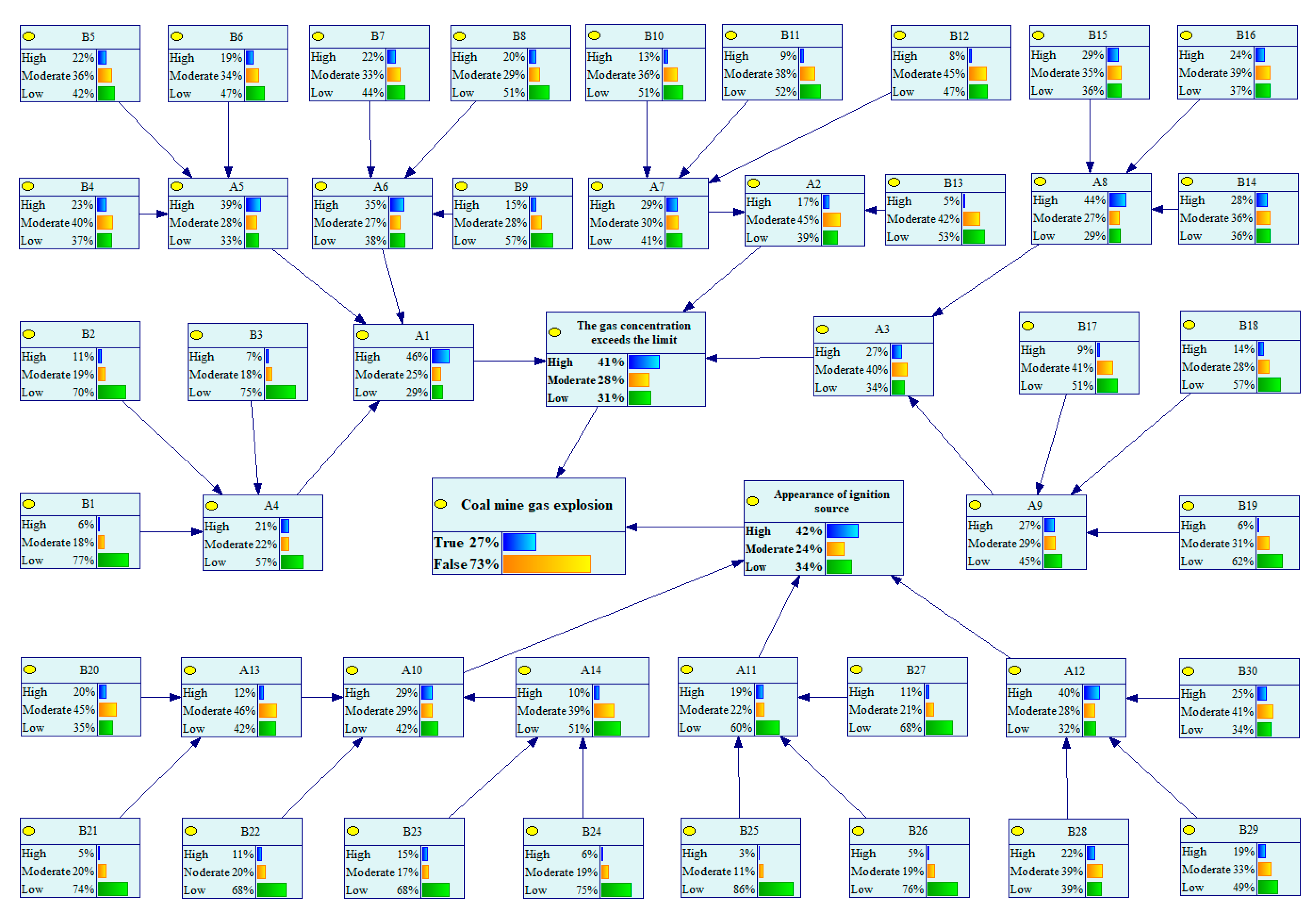
| Intermediate Event | Bottom Event | ||
|---|---|---|---|
| The gas concentration exceeds the limit | The ventilator works abnormally | ||
| Appearance of ignition source | |||
| Linguistic Variable | Short for Language Variable | Fuzzy Interval | |||
|---|---|---|---|---|---|
| a | b | c | d | ||
| Very high | VH | 0.8 | 0.9 | 1 | 1 |
| High | H | 0.7 | 0.8 | 0.8 | 0.9 |
| Relatively high | RH | 0.5 | 0.6 | 0.7 | 0.8 |
| Moderate | M | 0.4 | 0.5 | 0.5 | 0.6 |
| Relatively low | RL | 0.2 | 0.3 | 0.4 | 0.5 |
| Low | L | 0.1 | 0.2 | 0.2 | 0.3 |
| Very low | VL | 0 | 0 | 0.1 | 0.2 |
| Degree | Years of Working | Professional Relevance | Judging Confidence | Score |
|---|---|---|---|---|
| Doctorate | >30 | Very high | Very high | 0.250 |
| Master | 15~30 | High | High | 0.225 |
| Baccalaureate | 5~15 | Relatively high | Relatively high | 0.200 |
| Else | <5 | Moderate | Moderate | 0.175 |
| Degree | Years of Working | Professional Relevance | Judging Confidence | |
|---|---|---|---|---|
| Doctorate | 41 | Very high | Very high | 0.111 |
| Doctorate | 37 | Very high | High | 0.109 |
| Doctorate | 4 | Relatively high | Very high | 0.097 |
| Master | 9 | Moderate | Very high | 0.095 |
| Master | 3 | Moderate | High | 0.089 |
| Baccalaureate | 14 | Relatively high | Very high | 0.095 |
| Master | 13 | High | Very high | 0.100 |
| Baccalaureate | 11 | Relatively high | Very high | 0.095 |
| Doctorate | 12 | High | High | 0.106 |
| Doctorate | 9 | High | Very high | 0.103 |
| Parent Node | High | Moderate | Low | |||||||
|---|---|---|---|---|---|---|---|---|---|---|
| High | Moderate | Low | High | Moderate | Low | High | Moderate | Low | ||
| Child | High | 11 | 5 | 2 | 2 | 0 | 1 | 4 | 0 | 0 |
| node | Moderate | 1 | 1 | 1 | 1 | 6 | 2 | 2 | 2 | 1 |
| Low | 0 | 0 | 1 | 2 | 5 | 6 | 0 | 9 | 17 | |
| Parent Node | |||||||
|---|---|---|---|---|---|---|---|
| High | Moderate | Low | |||||
| Subjective | Objective | Subjective | Objective | Subjective | Objective | ||
| High | High | 0.856 | 0.917 | 0.072 | 0.083 | 0.072 | 0 |
| Moderate | 0.768 | 0.833 | 0.167 | 0.167 | 0.065 | 0 | |
| Low | 0.768 | 0.500 | 0.167 | 0.250 | 0.065 | 0.250 | |
| Moderate | High | 0.615 | 0.400 | 0.333 | 0.200 | 0.052 | 0.400 |
| Moderate | 0.581 | 0 | 0.363 | 0.545 | 0.056 | 0.455 | |
| Low | 0.303 | 0.111 | 0.394 | 0.222 | 0.303 | 0.667 | |
| Low | High | 0.593 | 0.667 | 0.259 | 0.333 | 0.148 | 0 |
| Moderate | 0.303 | 0 | 0.394 | 0.182 | 0.303 | 0.818 | |
| Low | 0.212 | 0 | 0.394 | 0.056 | 0.394 | 0.944 | |
| Root Nodes | State and Probability | ||
|---|---|---|---|
| High | Moderate | Low | |
| (0.010,0.021,0.110,0.210) 0.075 | (0.110,0.210,0.219,0.319) 0.176 | (0.791,0.891,0.981,0.991) 0.749 | |
| (0.078,0.157,0.178,0.278) 0.137 | (0.129,0.229,0.257,0.357) 0.190 | (0.750,0.850,0.899,0.950) 0.673 | |
| (0.020,0.040,0.120,0.220) 0.084 | (0.110,0.200,0.229,0.329) 0.179 | (0.781,0.881,0.962,0.981) 0.737 | |
| (0.208,0.308,0.390,0.490) 0.287 | (0.374,0.474,0.502,0.602) 0.401 | (0.238,0.338,0.419,0.519) 0.312 | |
| (0.189,0.289,0.352,0.452) 0.281 | (0.280,0.380,0.440,0.540) 0.360 | (0.280,0.380,0.440,0.540) 0.359 | |
| (0.384,0.484,0.524,0.624) 0.381 | (0.330,0.430,0.480,0.580) 0.343 | (0.221,0.321,0.410,0.510) 0.276 | |
| (0.208,0.308,0.390,0.490) 0.284 | (0.280,0.380,0.440,0.540) 0.334 | (0.360,0.460,0.480,0580) 0.382 | |
| (0.208,0.308,0.390,0.490) 0.247 | (0.280,0.380,0.440,0.540) 0.290 | (0.510,0.610,0.690,0.793) 0.462 | |
| (0.131,0.231,0.262,0.362) 0.184 | (0.241,0.341,0.420,0.520) 0.284 | (0.590,0.690,0.730,0.833) 0.532 | |
| (0.133,0.214,0.284,0.384) 0.164 | (0.442,0.542,0.584,0.684) 0.362 | (0.620,0.720,0.760,0.859) 0.475 | |
| (0.082,0.132,0.213,0.313) 0.116 | (0.491,0.591,0.650,0.750) 0.383 | (0.710,0.810,0.819,0.910) 0.501 | |
| (0.050,0.101,0.150,0.250) 0.095 | (0.533,0.633,0.702,0.802) 0.452 | (0.530,0.630,0.700,0.803) 0.452 | |
| (0.082,0.132,0.213,0.313) 0.110 | (0.592,0.692,0.732,0.832) 0.420 | (0.692,0.792,0.811,0.901) 0.470 | |
| (0.620,0.720,0.760,0.860) 0.347 | (0.663,0.763,0.781,0.881) 0.362 | (0.491,0.591,0.649,0.749) 0.291 | |
| (0.659,0.759,0.779,0.879) 0.364 | (0.630,0.730,0.748,0.848) 0.350 | (0.469,0.569,0.639,0.739) 0.286 | |
| (0.470,0.570,0.641,0.741) 0.299 | (0.682,0.782,0.791,0.891) 0.388 | (0.491,0.591,0.681,0.781) 0.314 | |
| (0.061,0.121,0.161,0.261) 0.109 | (0.435,0.535,0.603,0.703) 0.406 | (0.538,0.638,0.719,0.819) 0.485 | |
| (0.110,0.210,0.219,0.319) 0.181 | (0.202,0.302,0.371,0.471) 0.284 | (0.491,0.591,0.681,0.781) 0.536 | |
| (0.020,0.039,0.120,0.220) 0.081 | (0.261,0.361,0.430,0.530) 0.312 | (0.662,0.762,0.781,0.881) 0.608 | |
| (0.400,0.500,0.529,0.629) 0.397 | (0.459,0.559,0.619,0.719) 0.455 | (0.090,0.170,0.199,0.299) 0.148 | |
| (0.000,0.000,0.100,0.200) 0.065 | (0.130,0.230,0.260,0.360) 0.205 | (0.759,0.859,0.918,0.959) 0.730 | |
| (0.069,0.129,0.179,0.279) 0.142 | (0.118,0.187,0.267,0.367) 0.202 | (0.651,0.751,0.791,0.881) 0.656 | |
| (0.110,0.200,0.230,0.330) 0.183 | (0.099,0.168,0.228,0.328) 0.174 | (0.651,0.751,0.790,0.881) 0.644 | |
| (0.009,0.018,0.109,0.209) 0.075 | (0.120,0.220,0.239,0.339) 0.193 | (0.759,0.859,0.918,0.959) 0.733 | |
| (0.000,0.000,0.100,0.200) 0.070 | (0.040,0.080,0.140,0.240) 0.115 | (0.789,0.889,0.978,0.989) 0.816 | |
| (0.049,0.098,0.149,0.249) 0.114 | (0.118,0.198,0.257,0.357) 0.192 | (0.740,0.840,0.879,0.940) 0.695 | |
| (0.068,0.127,0.178,0.278) 0.135 | (0.137,0.226,0.286,0.386) 0.213 | (0.687,0.787,0.807,0.898) 0.652 | |
| (0.249,0.349,0.410,0.510) 0.278 | (0.414,0.514,0.556,0.656) 0.391 | (0.340,0.439,0.468,0.568) 0.332 | |
| (0.191,0.291,0.381,0.481) 0.233 | (0.349,0.449,0.491,0.591) 0.326 | (0.500,0.600,0.669,0.769) 0.441 | |
| (0.310,0.410,0.441,0.541) 0.308 | (0.442,0.542,0.584,0.684) 0.407 | (0.290,0.390,0.400,0.500) 0.286 | |
| Parent Node | High | Moderate | Low | |||||||
|---|---|---|---|---|---|---|---|---|---|---|
| High | Moderate | Low | High | Moderate | Low | High | Moderate | Low | ||
| Child | High | 0.768 | 0.683 | 0.485 | 0.692 | 0.394 | 0.233 | 0.483 | 0.213 | 0.042 |
| node | Moderate | 0.167 | 0.259 | 0.303 | 0.243 | 0.398 | 0.513 | 0.301 | 0.533 | 0.257 |
| Low | 0.065 | 0.058 | 0.212 | 0.065 | 0.208 | 0.254 | 0.216 | 0.254 | 0.701 | |
| Main Induced Paths | |
|---|---|
| The gas concentration exceeds the limit | (61%) → The gas concentration exceeds the limit (100%) |
| (61%) → The gas concentration exceeds the limit (100%) | |
| (61%) → The gas concentration exceeds the limit (100%) | |
| (25%) → The gas concentration exceeds the limit (100%) | |
| (25%) → The gas concentration exceeds the limit (100%) | |
| (37%) → The gas concentration exceeds the limit (100%) | |
| (37%) → The gas concentration exceeds the limit (100%) | |
| Appearance of ignition source | (53%) → Appearance of ignition source (100%) |
| (45%) → Appearance of ignition source (100%) | |
| (45%) → Appearance of ignition source (100%) | |
| (34%) → Appearance of ignition source (100%) | |
| (51%) → Appearance of ignition source (100%) | |
Disclaimer/Publisher’s Note: The statements, opinions and data contained in all publications are solely those of the individual author(s) and contributor(s) and not of MDPI and/or the editor(s). MDPI and/or the editor(s) disclaim responsibility for any injury to people or property resulting from any ideas, methods, instructions or products referred to in the content. |
© 2023 by the authors. Licensee MDPI, Basel, Switzerland. This article is an open access article distributed under the terms and conditions of the Creative Commons Attribution (CC BY) license (https://creativecommons.org/licenses/by/4.0/).
Share and Cite
Yang, J.; Zhao, J.; Shao, L. Risk Assessment of Coal Mine Gas Explosion Based on Fault Tree Analysis and Fuzzy Polymorphic Bayesian Network: A Case Study of Wangzhuang Coal Mine. Processes 2023, 11, 2619. https://doi.org/10.3390/pr11092619
Yang J, Zhao J, Shao L. Risk Assessment of Coal Mine Gas Explosion Based on Fault Tree Analysis and Fuzzy Polymorphic Bayesian Network: A Case Study of Wangzhuang Coal Mine. Processes. 2023; 11(9):2619. https://doi.org/10.3390/pr11092619
Chicago/Turabian StyleYang, Jinhui, Jin Zhao, and Liangshan Shao. 2023. "Risk Assessment of Coal Mine Gas Explosion Based on Fault Tree Analysis and Fuzzy Polymorphic Bayesian Network: A Case Study of Wangzhuang Coal Mine" Processes 11, no. 9: 2619. https://doi.org/10.3390/pr11092619
APA StyleYang, J., Zhao, J., & Shao, L. (2023). Risk Assessment of Coal Mine Gas Explosion Based on Fault Tree Analysis and Fuzzy Polymorphic Bayesian Network: A Case Study of Wangzhuang Coal Mine. Processes, 11(9), 2619. https://doi.org/10.3390/pr11092619






